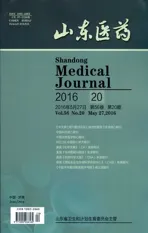舌下含服尘螨特异性免疫治疗小儿支气管哮喘合并变应性鼻炎临床观察
2016-05-10刘晓颖王群皇惠杰高琦苗青刘永革关辉向莉
刘晓颖,王群,皇惠杰,高琦,苗青,刘永革,关辉,向莉
(首都医科大学附属北京儿童医院,北京100045)
舌下含服尘螨特异性免疫治疗小儿支气管哮喘合并变应性鼻炎临床观察
刘晓颖,王群,皇惠杰,高琦,苗青,刘永革,关辉,向莉
(首都医科大学附属北京儿童医院,北京100045)
目的 探讨舌下含服尘螨特异性免疫治疗小儿支气管哮喘(简称哮喘)合并变应性鼻炎的临床效果。方法 选择尘螨致敏的哮喘合并变应性鼻炎患儿35例,均给予控制哮喘及鼻炎药物治疗同时行舌下免疫治疗(SLIT)24个月。观察治疗前、治疗后每6个月(共24个月)随访时平均每日症状用药计分(SMS)、峰流速值(PEFR)变化率,评估哮喘控制测试(ACT/C-ACT)及哮喘鼻炎视觉模拟评分(VAS),同时观察肺功能变化。同期检测血清户尘螨sIgE、粉尘螨sIgE和总IgE水平。结果 随访6、12、18、24个月平均SMS均低于治疗前,ACT/C-ACT评分均高于治疗前,哮喘、鼻炎VAS均低于治疗前(P均<0.05)。除18、24个月最大用力呼气峰流量占预计值的百分比、清晨和夜间PEFR变化率高于治疗前(P<0.05)外,其余肺功能指标与治疗前比较均无统计学差异。随访6个月时,血清户尘螨、粉尘螨sIgE及总IgE水平均较治疗前明显降低(P均<0.05),但血清户尘螨、粉尘螨sIgE水平与治疗24个月时比较无统计学差异。结论 SLIT可明显改善尘螨致敏哮喘合并变应性鼻炎患儿的临床症状,减少哮喘及变应性鼻炎相关用药量,但对肺功能影响较小;长期坚持SLIT可能改变机体对过敏原的免疫反应。
支气管哮喘;变应性鼻炎;舌下特异性免疫治疗
支气管哮喘(简称哮喘)和变应性鼻炎是儿童常见病、多发病,近年来其发病率逐年升高[1]。特异性免疫治疗(SIT)是哮喘和变应性鼻炎共同的治疗策略之一。常用的SIT为皮下免疫治疗(SCIT)和舌下免疫治疗(SLIT),其中SLIT给药便捷、安全性高,患儿和家长较容易接受。尘螨是儿童最常见的变应原之一,因此多数SIT是针对尘螨变应原进行的。2012年2月~2013年2月,我们观察了舌下含服尘螨特异性免疫治疗哮喘合并变应性鼻炎的临床效果。现分析结果并报告如下。
1 资料与方法
1.1 临床资料 选择同期我院收治的哮喘合并变应性鼻炎患儿35例,男26例、女9例,年龄(7.0±2.6)岁,均符合2008年版我国“儿童支气管哮喘诊断与防治指南”和2010年重庆版“儿童变应性鼻炎诊断和治疗指南”中的诊断标准。哮喘病程(3.2±1.7)年,变应性鼻炎病程(3.1±2.3)年。纳入标准:①年龄4~14岁;②户尘螨及粉尘螨致敏,即皮肤点刺试验(SPT)超过“++”和(或)血清特异性IgE(sIgE)2级以上[2,3];③哮喘及鼻炎视觉模拟评分(VAS)均≥2分;④哮喘病情为轻、中度,当前控制类药物治疗级别为1~3级[2];⑤能接受和配合健康管理。排除标准:①除户尘螨和粉尘螨外,存在其他变应原致敏,且其SPT阳性级别或sIgE水平大于户尘螨和粉尘螨;②哮喘及鼻炎VAS<2分;③第1秒用力呼气容积占预计值的百分比(FEV1%)<60%;④哮喘病情为重度持续,药物治疗级别4级或以上,病情仍未控制或部分控制;⑤存在SIT禁忌证;⑥既往行SIT患者。
1.2 治疗方法 根据2008年版我国“儿童支气管哮喘诊断与防治指南”和2010年重庆版“儿童变应性鼻炎诊断和治疗指南”,评估疾病分级和分度,定期再评估并调整治疗方案。所有患儿在哮喘药物控制治疗同时进行SLIT:舌下含服粉尘螨滴剂,包括剂量递增阶段(第1~3周)和剂量维持阶段(第4周开始)[4]。第1、2、3周分别使用滴剂1号(1 μg/mL)、2号(10 μg/mL)、3号(100 μg/mL)作为递增剂量,第1~7天按1、2、3、4、6、8、10滴依次递增服用;从第4周开始服用滴剂4号(333 μg/mL)作为维持剂量长期服用,每次3滴。用药方法:将滴剂滴于舌下,含服1~3 min,每日用药1次,固定时间用药,连续用药24个月。
1.3 相关指标观察
1.3.1 临床疗效及转归 ①治疗前、治疗后每6个月(共24个月)平均每日症状用药计分(SMS):SMS=日均哮喘用药评分+日均鼻炎用药评分+日均哮喘症状评分+日均鼻炎症状评分。日均哮喘及鼻炎用药评分:每日吸入布地奈德粉吸入剂100 μg或氟替卡松气雾剂125 μg记为1分,每日吸入布地奈德福莫特罗80/4.5 μg或沙美特罗替卡松50/100 μg记为2分,每日口服孟鲁司特4 mg或5 mg记为1分,每日鼻喷莫米松100 μg记为2分。哮喘症状包括咳嗽、喘息、胸闷、憋气以及夜间因哮喘症状憋醒,鼻炎症状包括喷嚏、流涕、鼻塞和鼻痒,每个症状分为无症状、轻度、中度、重度4个等级[5,6],分别计0、1、2、3分。②自主评估指标:治疗前、治疗后每6个月(共24个月)随访时进行哮喘控制测试(ACT)和哮喘及鼻炎VAS。ACT(适用年龄≥12岁)和C-ACT(儿童哮喘控制测试,适用年龄4~12岁)用于自主评估近1个月的哮喘控制状态[7];VAS用于自我评估近1个月哮喘或鼻炎症状的严重程度[8]。采用科卡PEF-2峰速仪测定最高呼气流量值(PEFR)。每日晨起后及睡前各测3次,取最大值。根据正常儿童PEFR预计值,获得PEFR实测值/PEFR预计值(PEFR% pred),即PEFR变化率[9]。
1.3.2 肺功能指标 治疗前、治疗后每6个月(共24个月)随访时,采用德国耶格MasterScreen型肺功能仪检测20例6岁以上患儿的肺通气功能,包括用力肺活量(FVC% pred)、第1秒用力呼气容积占预计值的百分比(FEV1% pred)、第1秒用力呼气容积占用力肺活量百分比(FEV1/FVC%)、最大用力呼气峰流量占预计值的百分比(PEF% pred)、最大呼气中段流量占预计值的百分比(MMEF%pred)[10]。
1.3.3 血清免疫学指标 治疗前及治疗6、12、24个月随访时,采用瑞典Pharmacia UniCAP100变应原检测系统和专用配套体外变应原诊断试剂对体外变应原sIgE(户尘螨sIgE、粉尘螨sIgE和总IgE)进行检测,采用荧光酶联免疫法。实验步骤和sIgE阳性分级判定标准参照文献[3]。

2 结果
2.1 SLIT不同时间临床效果比较 见表1。
2.2 SLIT不同时间肺功能参数变化 见表2。
2.3 治疗前后血清户尘螨、粉尘螨sIgE及总IgE比较 见表3。

表1 35例患儿治疗前后临床疗效指标比较
注:与治疗前比较,*P<0.05;与治疗12个月比较,#P<0.05。

表2 20例6岁以上患儿治疗前后最大用力呼气流量-容积曲线参数动态变化±s)
注:与治疗前比较,*P<0.05。

表3 35例患儿治疗前后血清户尘螨、粉尘螨sIgE及总IgE水平比较(n=35,kUA/L)
注:与治疗前比较,*P<0.05;与治疗12个月比较,#P<0.05。
3 讨论
研究发现,超过50%的哮喘患儿可合并变应性鼻炎。目前认为,哮喘和变应性鼻炎为同一气道的同一疾病,因而SIT为二者的共同治疗方案[1]。SLIT可改善哮喘和(或)变应性鼻炎患儿的临床症状、降低其症状评分并减少药物使用量[11,12];SLIT停药1年仍有存留效应,治疗结束4~5年仍可持续改善临床症状,而常规药物治疗停药后症状会再次出现[12~15]。本研究结果显示,35例患儿治疗期间平均SMS计分持续下降,治疗6、12、18、24个月时平均SMS计分与治疗前比较均明显下降,ACT/C-ACT评分均高于治疗前,哮喘、鼻炎VAS评分均低于治疗前。表明SLIT对尘螨致敏哮喘合并变应性鼻炎患儿治疗效果好,且治疗时间越长,临床症状改善越明显。
目前,SLIT对哮喘和(或)变应性鼻炎患儿肺功能的影响存在争议[11]。Niu等[16]对145例6~12岁轻中度持续哮喘患儿进行为期30周的尘螨SLIT,发现SLIT可明显改善患儿FVC、FEV1和PEF。Bahceciler等[17]研究发现,SLIT可明显改善哮喘合并变应性鼻炎患儿FEF25% pred、FEF50% pred和FEF75% pred;而Cao等[18]研究发现,SLIT半年对哮喘和(或)变应性鼻炎患儿FEV1无明显改善作用。本研究治疗18、24个月时患儿PEF% pred显著高于基线期,但其他肺功能指标并无明显改善。其原因可能为多数患儿SLIT前处于哮喘缓解期,肺功能多正常或小气道功能降低;而治疗前肺功能以小气道流速指标受限较明显,治疗后肺功能仍以持续小气道通气功能障碍为主。
免疫治疗可改变机体对过敏原的免疫反应,从而改变疾病的自然进程[19]。本研究发现,SLIT 2年时患儿血清户尘螨、粉尘螨sIgE及总IgE水平均较基线期显著下降,但与治疗1年时血清户尘螨、粉尘螨sIgE水平比较无统计学差异。表明SLIT需要长期坚持,短期效果不明显。
此外,本研究后期以SMS在12个月和24个月较基线期持续降低的病例作为持续有效组,否则为非持续有效组,结果35例患儿中持续有效组为24例,余11例为非持续有效组,且非持续有效组的基线期粉尘螨水平和总IgE水平显著高于持续有效组。提示基线期粉尘螨水平和总IgE水平可能影响临床疗效的稳定性,其水平升高患儿症状易反复或达到临床有效所需时间较长。粉尘螨致敏级别高的患儿临床疗效不稳定可能与家庭环境暴露因素相关。本课题组前期研究发现,哮喘患儿家庭内各季节室内各区域灰尘样本中Der f1平均含量为0.13 μg/g,显著高于Der p1平均含量0.02 μg/g,与Zhang等[20]研究结果基本一致。粉尘螨致敏级别高的患儿更易受到环境中粉尘螨致敏原的影响,这表明家庭环境因素同样可以影响舌下免疫治疗的疗效,提示在进行SLIT的同时不能忽视对家庭环境的控制即回避过敏原。但本研究未发现呼吸道感染影响SLIT疗效的持续稳定性,可能由于患儿均处于哮喘控制治疗状态下,气道炎症相对稳定。
综上所述,SLIT可明显改善尘螨致敏哮喘合并变应性鼻炎儿童的临床症状,减少哮喘及变应性鼻炎相关用药量,但对肺功能影响较小;长期坚持SLIT可能改变机体对过敏原的免疫反应。
[1] Bousquet J, Schünemann HJ, Samolinski B, et al. Allergic rhinitis and its impact on asthma (ARIA): achievements in 10 years and future needs[J]. J Allergy Clin Immunol, 2012,130(5):1049-1062.
[2] Homburger HA. Diagnosing allergic diseases in children. Practical recommendations for consulting pathologists[J]. Arch Pathol Lab Med, 2004,128(9):1028-1031.
[3] Sander I, Kespohl S, Merget R, et al. A new method to bind allergens for the measurement of specific IgE antibodies[J]. Int Arch Allergy Immunol, 2005,136(1):39-44.
[4] 陈伯亚,龙自铭,黄燕君,等.舌下含服粉尘螨滴剂治疗单一和多重过敏变应性鼻炎患者的临床疗效评估[J].中华耳鼻咽喉头颈外科杂志,2013,48(7):549-554.
[5] Yukselen A, Kendirli SG, Yilmaz M, et al. Effect of one-year subcutaneous and sublingual immunotherapy on clinical and laboratory parameters in children with rhinitis and asthma: a randomized, placebo-controlled, double-blind, double-dummy study[J]. Int Arch Allergy Immunol, 2012,157(3):288-298.
[6] Yukselen A, Kendirli SG, Yilmaz M, et al. Two year follow-up of clinical and inflammation parameters in children monosensitized to mites undergoing subcutaneous and sublingual immunotherapy[J]. Asian Pac J Allergy Immunol, 2013,31(3):233-241.
[7] Voorend-van Bergen S, Vaessen-Verberne AA, Landstra AM, et al. Monitoring childhood asthma: web-based diaries and the asthma control test[J]. J Allergy Clin Immunol, 2014,133(6):1599-1605.
[8] Demoly P, Bousquet PJ, Mesbah K, et al. Visual analogue scale in patients treated for allergic rhinitis: an observational prospective study in primary care: asthma and rhinitis[J]. Clin Exp Allergy, 2013,43(8):881-888.
[9] 丁莉平,冯彤,孙芳邻.峰流速仪与流速容积曲线在儿童哮喘管理中的临床应用[J].中国医药指南,2014,12(7):88-89.
[10] 中华医学会呼吸病学分会肺功能专业组.肺功能检查指南(第二部分)——肺量计检查[J].中华结核和呼吸杂志,2014,37(7):481-486.
[11] Pleskovic N, Bartholow A, Skoner DP. Sublingual immunotherapy in children: the recent experiences[J]. Curr Opin Allergy Clin Immunol, 2014,14(6):582-590.
[12] Yukselen A, Kendirli SG. Role of immunotherapy in the treatment of allergic asthma[J]. World J Clin Cases, 2014,2(12):859-865.
[13] Marogna M, Spadolini I, Massolo A, et al. Long-lasting effects of sublingual immunotherapy according to its duration: a 15-year prospective study[J]. J Allergy Clin Immunol, 2010,126(5):969-975.
[14] Wahn U, Tabar A, Kuna P, et al. Efficacy and safety of 5-grass-pollen sublingual immunotherapy tablets in pediatric allergic rhinoconjunctivitis[J]. J Allergy Clin Immunol, 2009,123(1):160-166.
[15] Halken S, Agertoft L, Seidenberg J, et al. Five-grass pollen 300IR SLIT tablets: efficacy and safety in children and adolescents[J]. Pediatr Allergy Immunol, 2010,21(6):970-976.
[16] Niu CK, Chen WY, Huang JL, et al. Efficacy of sublingual immunotherapy with high-dose mite extracts in asthma: a multi-center, double-blind, randomized, and placebo-controlled study in Taiwan[J]. Respir Med, 2006,100(8):1374-1383.
[17] Bahceciler NN, Arikan C, Taylor A, et al. Impact of sublingual immunotherapy on specific antibody levels in asthmatic children allergic to house dust mites[J]. Int Arch Allergy Immunol, 2005,136(3):287-294.
[18] Cao LF, Lu Q, Gu HL, et al. Clinical evaluation for sublingual immunotherapy of allergic asthma and atopic rhinitis with Dermatophagoides Farinae Drops[J]. Zhonghua Er Ke Za Zhi, 2007,45(10):736-741.
[19] James LK, Shamji MH, Walker SM, et al. Long-term tolerance after allergen immunotherapy is accompanied by selective persisitence of blocking antibodies[J]. J Allergy Clin Immunol, 2011,127(2):509-516.
[20] Zhang C, Gjesing B, Lai X, et al. Indoor allergen levels in Guangzhou city, southern China[J]. Allergy, 2011,66(2):186-191.
Clinical observation of sublingual dust mite specific immunotherapy in treatment of children with asthma and allergic rhinitis
LIUXiaoying,WANGQun,HUANGHuijie,GAOQi,MIAOQing,LIUYongge,GUANHui,XIANGLi
(BeijingChildren’sHospital,CapitalMedicalUniversity,Beijing100045,China)
Objective To observe the clinical effect of two-year sublingual dust mite specific immunotherapy in treatment of children with allergic rhinitis and asthma. Methods Thirty-five children sensitizing to dust mite with mild or moderate asthma complicated with allergic rhinitis received 24-month sublingual immunotherapy (SLIT) and drug treatment of asthma and rhinitis at the same time. We recorded the daily medication scores (SMS) and peak expiratory flow rate (PEF) before treatment and every 6 months after treatment. We assessed the asthma control test/children-asthma control test (ACT/C-ACT), visual analog scale (VAS) and observed the pulmonary function. Serum dermatophagoides pteronyssinus sIgE, dermatophagoides farinae sIgE and whole IgE levels were detected. Results At the follow-up of 6, 12, 18 and 24 months, the mean SMS was significantly lower than that before treatment (allP<0.05), ACT/C-ACT score was significantly higher than that before treatment (P<0.05), and the VAS score of asthma and rhinitis was lower than that before treatment (P<0.05). The peak expiratory flow rate (PEF) at 18 and 24 months was significantly higher than that of the baseline (P<0.05). There was no significant difference between the baseline and follow-up period of the rest lung function parameters. Serum immunological indexes of dermatophagoides pteronyssinus and dermatophagoides farinae sIgE in the follow-up of 24 months decreased significantly as compared with that before treatment. There was no significant difference in dermatophagoides pteronyssinus and dermatophagoides farinae sIgE levels between the two-year treatment and one-year treatment. Conclusions SLIT can significant improve the clinical symptoms of children sensitizing to dust mite with mild or moderate asthma complicated with allergic rhinitis and reduce asthma and allergic rhinitis medication, but it has little effect on pulmonary function. Only with long-term adherence to SLIT can change the body′s immune response to allergens.
bronchial asthma; allergic rhinitis; sublingual specific immunotherapy
首都特色课题(Z151100004015030);北京市科技计划(Z131100006813044)。
刘晓颖(1989-),女,硕士在读,主要研究方向为儿童哮喘及过敏性疾病。E-mail: bchlxy2013@163.com
向莉(1971-),女,主任医师,主要研究方向为儿童呼吸系统疾病、变态反应性疾病。E-mail: drxiangli@163.com
10.3969/j.issn.1002-266X.2016.20.002
R725.6
A
1002-266X(2016)20-0005-04
2015-12-18)
